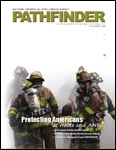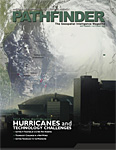Geospatial Intelligence and Katrina
The NGA and Katrina
Government and private sector geospatial intelligence practitioners have good reason to be proud of the contribution of GIS&T to Katrina response and recovery efforts. The National Geospatial-Intelligence Agency was mentioned in the "Federal Response to Hurricane Katrina" report in Appendix B on "What Went Right":
The National Geospatial-Intelligence Agency (NGA) started collecting key infrastructure-related information (i.e. on airports, hospitals, police stations, emergency operations centers, highways, schools, etc.) well in advance of landfall and got this information into the hands of Federal, State, and local first responders in the affected region. As the storm was tracked, NGA pre-deployed analysts and mobile systems to the affected areas that provided expertise and information on the ground and facilitated the delivery of additional information from NGA offices elsewhere. Because they had assets in place and focused on the region, NGA provided the first comprehensive overview of the damage resulting from the hurricane and flood. NGA merged imagery with other information, creating hundreds of intelligence products per day that could be used and applied by response professionals to aid in decision-making. NGA assessments were multi-dimensional, timely, relevant, and continuous. They addressed many issues, including but not limited to: recovery planning and operations, transportation infrastructure, critical and catastrophic damage, dike stability and breaches, industry damage, and hazard spills. The NGA World Wide Navigational Warning Service also provided navigation information to the U.S. Navy, Merchant Marine, and Coast Guard, and relayed messages from the National Weather Service to people at sea. NGA also aided in the location and recovery of oil platforms. The imagery activities of NGA were essential to the restoration of critical infrastructure." See Also: U.S. National Geospatial Intelligence Agency, "Geospatial Intelligence Aids Hurricane Recovery Efforts," news release, September 7, 2005.
NGA is proud of its contribution to hurricane preparedness and relief efforts.
Reading
Read the September-October 2005 issue of the NGA Pathfinder magazine. The issue title is "NGA Makes the Difference: Hurricanes and Technology Challenges."
Many of my students in this course are geospatial analysts for NGA or the military. Shawna Wolin was a student in the first offering of this class, and she is the co-author of an article in the July-August 2006 NGA Pathfinder magazine.
Reading
Read Shawna Wolin's article "Partnerships: FEMA Looks to NGA for Disaster Help" (page 29-30) in the July-August 2006 issue of the NGA Pathfinder magazine for insight on how a classmate might be directly involved in the issues we study.

A Critical Look
My mission in teaching this course is to teach you to use higher order thinking skills and, most importantly, to be CRITICAL THINKERS. So let me tell you a story about trying to craft this lesson. The Penn State GEOINT faculty paid a visit to Washington to talk to key players in the geospatial intelligence business for national security, disaster preparedness, and international disaster relief. This included visiting the NGA College at Fort Belvoir and FEMA Headquarters in Washington DC. My mission was to gain some insight into these topics and ask the experts for case studies that would look at what went right and wrong in the GWOT, Hurricane Katrina, and the Asian Tsunami (our three case studies). To make a long story short, all the agency representatives thought this course and program are a great idea. They especially liked the critical thinking component of this course. However, no one wanted to take any risk by providing any unclassified case studies that were self critical of their own operations. Perhaps these case studies do not exist or they are classified and unavailable. What is available from NGA is public affairs material like the Pathfinder magazine. Now do not take me wrong. I have some background with the world of secrets and I understand protecting sensitive information and sources and methods. However, my experience and personal opinion is that too often secrecy is used to prevent true critical analysis which is essential to process and product improvement.
You just read several articles on NGA contributions during Katrina. Let me tell you about an interview with a key geospatial player from FEMA and that person's insights on NGA support for FEMA during Hurricane Katrina. (As the person did not respond to my request to provide written notes or participate in our forum, I will respect their privacy and leave them unnamed.)
The FEMA geospatial analysts had numerous requirements for imagery, data, and processed geospatial analytical products. NGA was on the scene and highly motivated to help. The problem was one of culture and orientation. Here are some of the issues the FEMA person noted:
- There were issues about data sharing due to the classified nature of some of the collection systems. Fortunately, commercial imagery solved many of these problems. However, the culture of secrecy hinders interagency coordination between defense oriented agencies such as NGA, and other federal, state, local, and NGO agencies who do not share that culture nor have the required clearances.
- NGA did not understand FEMA procedures and processes and thus did not always provide usable products. For example, FEMA must do damage assessments at various scales to include house by house assessments. These assessments drive the amount of relief funds that FEMA provides to individual homeowners. Katrina caused devastation on a scale that overwhelmed traditional ground damage assessment survey methods. Geospatial approaches seemed a natural solution to conduct damage assessment on such destruction. NGA used remote sensing products processed with GIS to provide damage assessment maps. Unfortunately, the map data did not suit the needs of FEMA and was unusable. The issue was educating the NGA analysts on FEMA customer needs, and having NGA be nimble enough to understand and craft technical solutions capable of creating useful products in a timely fashion.
- FEMA is a civilian agency that has been in crisis for over a decade. NGA is a Department of Defense combat support agency as well as a member of the national intelligence community. There are cultural gaps between NGA (DOD really) and FEMA that get in the way of truly seamless interagency coordination.
Now for those of you at NGA who may have worked Katrina and might be fuming, do not take the above observations as a criticism of you or NGA. My point is that to get better, you have to be willing to take a hard and candid look at what went wrong so you can get better for the next time. Those of us outside the federal agencies hope they are doing this internally, because they certainly are not doing it in view of the public. And that is a shame because there are citizens and scholars who might well have an outside perspective useful to the discussion.
Now consider the lessons learned from members of the American Society of Photogrammetry and Remote Sensing (ASPRS) who were involved in Katrina. Read the report below and then look over the resources on the ASPRS website at http://www.asprs.org/news/disaster_ws. The presentations are especially interesting. Andrew MacInnes of Plaquemines Parrish, LA is a graduate of the Penn State online masters in GIScience Program. His presentation on "Airborne and Satellite Imagery Use and Collection for Katrina and Rita" is very interesting and it has some amazing images.
Reading
Read the ASPRS report "Results and Recommendations on the Role of Airborne and Commercial Satellite Imagery in Emergency Response"

As a final reading, consider this most interesting essay from the SSRC Understanding Katrina Project. Note the author's academic background and affiliation. Consider the implications of her insights for both geospatial intelligence, and the broader issues we have been studying.

